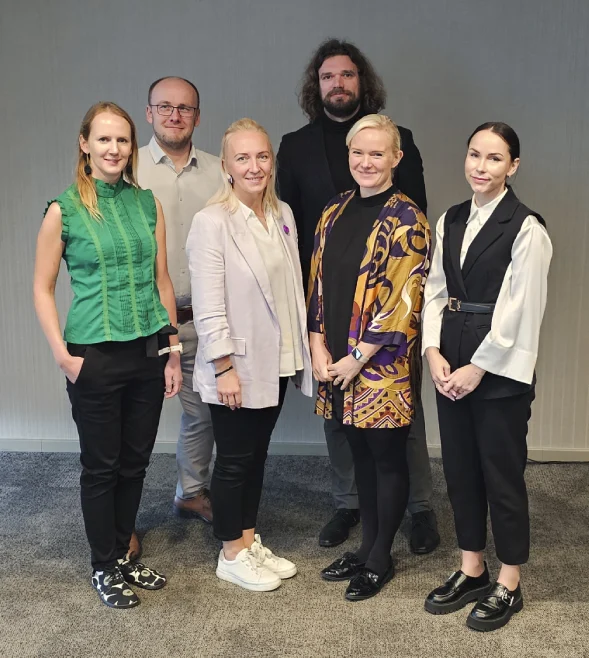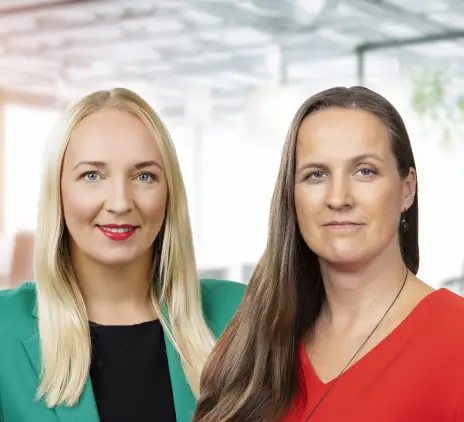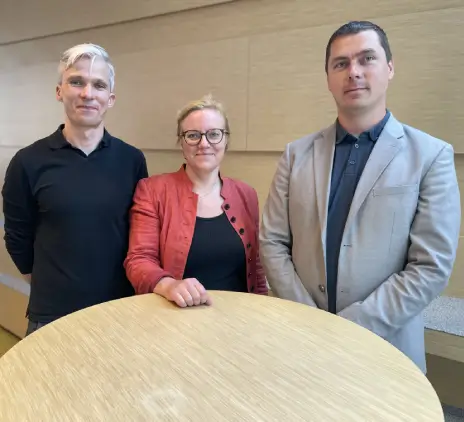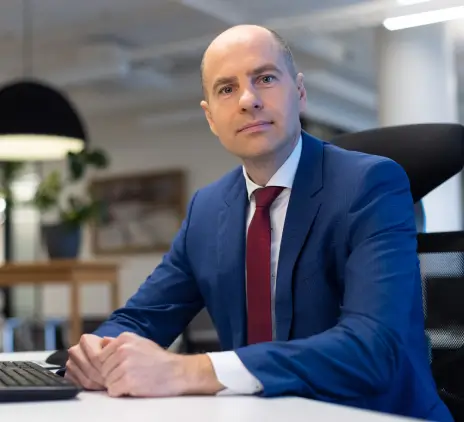-
Other audit services
We help clients with the application and use of foreign financial aid of EU and other funds and help prepare financial reports.
-
Audit calculator
The calculator will answer if the company's sales revenue, assets or number of employees exceed the limit of an inspection or audit.
-
Payroll and related services
We perform payroll accounting for companies whether they employ a few or hundreds of employees.
-
Tax accounting
Grant Thornton Baltic's experienced tax specialists support accountants and offer reasonable and practical solutions.
-
Reporting
We prepare annual reports in a timely manner. We help to prepare management reports and various mandatory reports.
-
Consolidation of financial statements
Our experienced accountants and advisors help you prepare consolidation tables and make the consolidation process more efficient.
-
Consultancy and temporary staff
Our experienced specialists advise on more complex accounting transactions, rectify poor historic accounting, and offer the temporary replacement of an accountant.
-
Outsourced CFO service
Our CFO service is suitable for companies of all sizes and in all industries. We offer services to our clients in the required amount and competences.
-
Assessment of accounting processes
We help companies to implement accounting practices that are in compliance with local and international standards.
-
Accounting services for small businesses
We offer affordable service for small businesses. We help organize processes as smartly and cost-effectively as possible.
-
Cryptocurrency accounting
We keep up with blockchain technology to serve and advise crypto companies. We are supported by a network of colleagues in 130 countries.
-
Trainings and seminars
Our accountants have experience in all matters related to accounting and reporting. We offer our clients professional training according to their needs.

-
Business advisory
We offer legal support to both start-ups and expanding companies, making sure that all legal steps are well thought out in detail.
-
Fintech advisory
Our specialists advise payment institutions, virtual currency service providers and financial institutions.
-
Corporate advisory
We advise on legal, tax and financial matters necessary for better management of the company's legal or organizational structure.
-
Transaction advisory
We provide advice in all aspects of the transaction process.
-
Legal due diligence
We thoroughly analyze the internal documents, legal relations, and business compliance of the company to be merged or acquired.
-
In-house lawyer service
The service is intended for entrepreneurs who are looking for a reliable partner to solve the company's day-to-day legal issues.
-
The contact person service
We offer a contact person service to Estonian companies with a board located abroad.
-
Training
We organize both public trainings and tailor made trainings ordered by clients on current legal and tax issues.
-
Whistleblower channel
At Grant Thornton Baltic, we believe that a well-designed and effective reporting channel is an efficient way of achieving trustworthiness.

-
Business model or strategy renewal
In order to be successful, every company, regardless of the size of the organization, must have a clear strategy, ie know where the whole team is heading.
-
Marketing and brand strategy; creation and updating of the client management system
We support you in updating your marketing and brand strategy and customer management system, so that you can adapt in this time of rapid changes.
-
Coaching and development support
A good organizational culture is like a trump card for a company. We guide you how to collect trump cards!
-
Digital services
Today, the question is not whether to digitize, but how to do it. We help you develop and implement smart digital solutions.
-
Sales organisation development
Our mission is to improve our customers' business results by choosing the right focuses and providing a clear and systematic path to a solution.
-
Business plan development
A good business plan is a guide and management tool for an entrepreneur, a source of information for financial institutions and potential investors to make financial decisions.
-
Due diligence
We perform due diligence so that investors can get a thorough overview of the company before the planned purchase transaction.
-
Mergers and acquisitions
We provide advice in all aspects of the transaction process.
-
Valuation services
We estimate the company's market value, asset value and other asset groups based on internationally accepted methodology.
-
Forensic expert services
Our experienced, nationally recognized forensic experts provide assessments in the economic and financial field.
-
Business plans and financial forecasts
The lack of planning and control of cash resources is the reason often given for the failure of many businesses. We help you prepare proper forecasts to reduce business risks.
-
Outsourced CFO service
Our CFO service is suitable for companies of all sizes and in all industries. We offer services to our clients in the required amount and competences.
-
Reorganization
Our experienced reorganizers offer ways to overcome the company's economic difficulties and restore liquidity in order to manage sustainably in the future.
-
Restructuring and reorganisation
We offer individual complete solutions for reorganizing the structure of companies.
-
Corporate taxation
We advise on all matters related to corporate taxation.
-
Value added tax and other indirect taxes
We have extensive knowledge in the field of VAT, excise duties and customs, both on the national and international level.
-
International taxation
We advise on foreign tax systems and international tax regulations, including the requirements of cross-border reporting.
-
Transfer pricing
We help plan and document all aspects of a company's transfer pricing strategy.
-
Taxation of transactions
We plan the tax consequences of a company's acquisition, transfer, refinancing, restructuring, and listing of bonds or shares.
-
Taxation of employees in cross-border operations
An employee of an Estonian company abroad and an employee of a foreign company in Estonia - we advise on tax rules.
-
Tax risk audit
We perform a risk audit that helps diagnose and limit tax risks and optimize tax obligations.
-
Representing the client in Tax Board
We prevent tax problems and ensure smooth communication with the Tax and Customs Board.
-
Taxation of private individuals
We advise individuals on personal income taxation issues and, represent the client in communication with the Tax and Customs Board.
-
Pan-Baltic tax system comparison
Our tax specialists have prepared a comparison of the tax systems of the Baltic countries regarding the taxation of companies and individuals.
-
Recruitment services – personnel search
We help fill positions in your company with competent and dedicated employees who help realize the company's strategic goals.
-
Recruitment support services
Support services help to determine whether the candidates match the company's expectations. The most used support services are candidate testing and evaluation.
-
Implementation of human resource management processes
We either assume a full control of the launch of processes related to HR management, or we are a supportive advisory partner for the HR manager.
-
Audit of HR management processes
We map the HR management processes and provide an overview of how to assess the health of the organization from the HR management perspective.
-
HR Documentation and Operating Model Advisory Services work
We support companies in setting up HR documentation and operational processes with a necessary quality.
-
Employee Surveys
We help to carry out goal-oriented and high-quality employee surveys. We analyse the results, make reports, and draw conclusions.
-
HR Management outsourcing
We offer both temporary and permanent/long-term HR manager services to companies.

-
Internal audit
We assist you in performing the internal audit function, performing internal audits and advisory work, evaluating governance, and conducting training.
-
Internal Audit in the Financial Services Sector
We provide internal audit services to financial sector companies. We can support the creation of an internal audit function already when applying for a sectoral activity license.
-
Audit of projects
We conduct audits of projects that have received European Union funds, state aid, foreign aid, or other grants.
-
Prevention of money laundering
We help to prepare a money laundering risk assessment and efficient anti-money laundering procedures, conduct internal audits and training.
-
Risk assessment and risk management
We advise you on conducting a risk assessment and setting up a risk management system.
-
Custom tasks
At the request of the client, we perform audits, inspections and analyzes with a specific purpose and scope.
-
External Quality Assessment of the Internal Audit Activity
We conduct an external evaluation of the quality of the internal audit or provide independent assurance on the self-assessment.
-
Whistleblowing and reporting misconduct
We can help build the whistleblowing system, from implementation, internal repairs and staff training to the creation of a reporting channel and case management.
-
Sustainability advisory
We help solve issues related to the environment, social capital, employees, business model and good management practices.
-
Sustainability audit
Our auditors review and certify sustainability reports in accordance with international standards.
-
Sustainable finance
We help investors to analyze the environmental issues, social responsibility and good management practices of the company of interest.
-
Sustainable tax
Our international tax specialists define the concept of sustainable tax behavior and provide services related to sustainable tax behavior.
-
Digital strategy
We help assess the digital maturity of your organization, create a strategy that matches your needs and capabilities, and develop key metrics.
-
Intelligent automation
We aid you in determining your business’ needs and opportunities, as well as model the business processes to provide the best user experience and efficiency.
-
Business Intelligence
Our team of experienced business analysts will help you get a grip on your data by mapping and structuring all the data available.
-
Cybersecurity
A proactive cyber strategy delivers you peace of mind, allowing you to focus on realising your company’s growth potential.
-
Innovation as a Service
On average, one in four projects fails and one in two needs changes. We help manage the innovation of your company's digital solutions!


In an era when new and profitable opportunities keep on presenting themselves for investing and many of these are not supervised by Financial Supervision Authority or other regulator, be on the lookout for specific red flags in order to prevent fraud.
Twenty to twenty five years ago, investment was mainly a matter of investing on the stock market, but now the possibilities are wider.
“Now there are possibilities of investing on the alternative investment market, investing in venture capital, it’s possible to buy loan stock and shares of small non-public companies through crowdfunding,” said Nasdaq Tallinn’s listing and supervisory committee member and managing partner of the investment management company Avaron, Kristel Kivinurm-Priisalm on the Äripäev radio programme "Kasvukursil".
But many of the alternative investments, including even savings and loans, are not supervised by Financial Supervision Authority and are riskier for the investor.
Information on companies can be vague
Attorney at law Marko Kairjak of Ellex Raidla law firm noted that companies not under Financial Supervision Authority oversight may not report enough information about themselves. “The ones who are not subject to supervision are obliged only to submit the basic annual report.”
This may not reflect the most accurate information about the company. “It should be taken into account that the report for the previous annual report must generally be filed by June of the following year. The reports currently available are for 2021 and if anyone wishes to make an investment, they must take into account this blind spot. The public information will soon be 15 months old,” said Kairjak.
Grant Thornton Baltic’s partner and head of audit and assurance services Mart Nõmper agrees that it is a golden age for fraud. "Every investor’s own responsibility and level of duty of care is significantly higher now.”
Nõmper referred to a master’s thesis that profiled companies with a larger than normal likelihood of fraud. “Such companies are usually small, they lack an audit committee and internal audit, they were making a loss prior to the fraud and the management has a very significant role in influencing decision-making,” he said, adding that the risk criteria are met in the case of many companies listed on First North Tallinn.
Companies ought to have a proper auditor
Kivinurm-Priisalm said one red flag and indicator suggestive of possible fraud was if a company lacked an auditor completely or had a very small audit firm providing the assurance service. “For example, the companies on the main list of Tallinn stock exchange are all without exception audited by the four biggest audit companies, while only one-fifth of the ones on First North are handled by the largest auditors. 40 per cent of First North companies are audited by companies that employ less than four people.”
Kivinurm-Priisalm says small audit companies are not suitable choices for publicly listed companies, because they simply lack the resources and people to manage the necessary competence for such weighty work. “In addition, it must be possible for auditors to discuss the more complicated cases with others,” she noted. “So if a company is audited by a small firm called Man and Dog, it should trigger a warning light for the investor. Bernie Madoff’s notorious company was also audited by a similar small business”.
In addition, Kivinurm-Priisalm recommends that investors check the quality of the auditor that is looking for their business, and this can be done via the website ajn.ee. High-quality auditors are the ones who were given a green or yellow assessment, while orange and red by the auditor’s name is a sign of substandard quality. “For example, Lahendused Pluss, which audited ERIAL was red in 2021 and orange last year,” noting that the investors who parked their money in the savings and loan would have been able to easily do their research and see the red flag.
Risks related to employees
Kivinurm-Priisalm emphasizes that although the Tallinn stock exchange’s listing and supervisory committee is engaged in risk mitigation, they cannot evaluate a specific company’s business model. “What we can do is look at the company’s risks,” she said.
One risk vector, according to Kivinurm-Priisalm, is when a public company raising funds has a management board of one. “That substantially increases the risks for investors, because responsibility is not shared, complicated issues are not decided on collectively.”
Nõmper says fraud falls into two categories – some are committed by employees and other that are committed by management or owners. “Frequently an accountant or warehouse worker will perpetrate fraud and they wind up with the company’s property.” That is the first type, he said. “Yet the impact of such fraud incidents are ten times lesser than management-perpetrated fraud. The latter are harder for auditors to detect as well. Small companies do not have control systems or the management can circumvent them.” The four-eyes principle should be applied, he said. He added that statistically speaking, whistleblowers uncover the most cases of fraud.
The expert notes that the risk of fraud increases if the triangle of fraud based on psychology has been fulfilled. “Three aspects that lead to fraud are: the motive to commit fraud, the fraudster must have a justification or reasoning for their action, and they must have opportunity to do it.” “For example, a justification might be that investors want to see higher profit figures, the motive is the bonus or stock options received for it and the inefficient control environment creates the opportunity, which is weaker in smaller companies, while companies in the stock market’s main list have an audit committee to hedge the risk,“ Nõmper said.
Popping the balance-sheet balloon
Experts also recommend devoting attention to what is on the balance sheet of a company seeking financing. “Many companies have a great deal of intangible assets. The auditors should examine whether they have been properly valuated but if there are only 1-2 people with the right skillsets it is hard to see that they will be able to say what the value of the intangible assets are for a specific company,” Nõmper said, referring to the aspect of why it is important to find an auditor. “If intangible assets exceed owners’ equity and are not assessed correctly, it may be that the company in fact has no assets.”
Kairjak noted that the need to assess the balance sheet undoubtedly exists, but it is not always worth counting on a very good auditor. „The Wirecard scandal is a good example of how, no matter how good the regulations or auditors are, deliberate fraud is still a possibility.” What happened in that case was that Wirecard was a regulated payment institution and one of the biggest fintech success stories, but it turned out that the balance sheet was largely air. It did not actually have the money that investors were told it had, plus payment service clients who used the platform also lost their money.”
Still, if such an incident occurs, there may be a way of holding the auditor accountable. And for that to happen, it is very important that the auditor is properly selected because the size of the sum to be collected depends on the extent of the auditor’s liability insurance coverage. Auditing companies are generally “thin” counterparties and there is not much to collect in damages from them. But they are required by law to have insurance coverage so that the insurer pays for the auditing company if there is trouble. A minimum policy is often taken out – 64,000 euros. Larger offices have the advantage of affording greater coverage, which may not be less than the value of the two largest client contracts.
Management members should be checked
In addition, Kivinurm-Priisalm recommends checking the management board members of the company being invested in. “The easiest is to methodically Google the people on the management board and supervisory board and see what turns up, whether they have been afoul of the law or other matters,” said the expert.
Kivinurm-Priisalm also recommends running a check on other companies related to the members of management bodies. It is easy to do this using the teatmik.ee site, which shows tax arrears, tax deferrals, court rulings. ”Anything that could switch on a warning light in the investor’s head.”
This sort of pre-investment check is especially important for non-listed companies that are not under the supervision of Financial Supervision Authority. “Otherwise, usually the Financial Supervision Authority will do this work for you, but not on the unregulated market,” said Kairjak. He added that going to court is the only recourse when getting one’s fingers burned investing on the unregulated market. “At the same time, the legal costs involved in recouping one’s investment may be larger than the investment itself,” he warned.
Looking at the future, Kivinurm-Priisalm said Estonian investment culture will catch up to the rest of the West. For instance, a possible area for improvement would be if local listed companies publicly disclosed the management’s forecasts for the year. Likewise, if listed companies have companies related to the owners providing services to them, where the expenses might not be visible to small shareholders. “It’s important for smaller investors to learn what the management thinks, for many of today’s First North companies financial forecasts simply consist of a hockey stick graph that the management doesn’t really believe.”
In closing, Kivinurm-Priisalm recommends that every investor should look at the risks bound up in the promised investment return. “Many investors do not understand the relationship between risk and reward. If they prefer crowdfunding to a bond with an 8-10% yield, they don’t realize that they are also taking a higher risk. The latter is not subject to oversight and if trouble arises, the investor has to deal with the consequences,” she said. “Venture capital investments can be made, but then the risks should always be diversified. The share of alternative market companies could be capped at 5% of the portfolio.”
If you have similar challenges and questions, please contact our specialists.





